
Napa 85 435 Automatic Battery Charger

IMPORTANT SAFETY INSTRUCTIONS
SAVE THESE INSTRUCTIONS
- This manual contains important safety and operating instructions.
RISK OF ELECTRIC SHOCK OR FIRE. - Keep out of reach of children.
- Do not expose the charger to rain or snow. Use only recommended attachments. Use of an attachment not recommended or sold by Schumacher® Electric Corporation may result in a risk of fire, electric shock or injury to persons or damage to property.
- To reduce the risk of damage to the electric plug or cord, pull by the plug rather than the cord when disconnecting the charger.
- An extension cord should not be used unless necessary. Use of an improper extension cord could result in a risk of fire and electric shock. If an extension cord must be used, make sure:
- The pins on the plug of the extension cord are the same number, size, and shape as those of the plug on the charger.
- The extension cord is properly wired and in good electrical condition.
- The wire size is large enough for the AC ampere rating of the charger as specified in section 8.
- To reduce the risk of electric shock, unplug the charger from the outlet before attempting any maintenance or cleaning. Simply turning off the controls will not reduce this risk.
- Do not operate the charger with a damaged cord or plug; have the cord or plug replaced immediately by a qualified service person. (Call customer service at: 1-800-621-5485.)
- Do not operate the charger if it has received a sharp blow, been dropped or otherwise damaged in any way; take it to a qualified service person. (Call customer service at: 1-800-621-5485.)
- Do not disassemble the charger; take it to a qualified service person when service or 1.8 repair is required. Incorrect reassembly may result in a risk of fire or electric shock. (Call customer service at: 1-800-621-5485.)
RISK OF EXPLOSIVE GASES.
WORKING IN THE VICINITY OF A LEAD-ACID BATTERY IS DANGEROUS. 1.9 BATTERIES GENERATE EXPLOSIVE GASES DURING NORMAL BATTERY OPERATION. FOR THIS REASON, IT IS OF UTMOST IMPORTANCE THAT YOU FOLLOW THE INSTRUCTIONS EACH TIME YOU USE THE CHARGER.
- To reduce the risk of a battery explosion, follow these instructions and those published by the battery manufacturer and the manufacturer of any equipment you intend to use in the vicinity of the battery. Review the cautionary markings on these products and on the engine.
- This charger employs parts, such as switches and circuit breakers, that tend to produce arcs 1.11 and sparks. If used in a garage, locate this charger 18 inches or more above floor level.
PREPARING TO CHARGE
RISK OF CONTACT WITH BATTERY ACID. BATTERY ACID IS A HIGHLY CORROSIVE SULFURIC ACID.
- If it is necessary to remove the battery from the vehicle to charge it, always remove the grounded terminal first. Make sure all of the accessories in the vehicle are off to prevent arcing.
- Be sure the area around the battery is well ventilated while the battery is being charged.
- Clean the battery terminals before charging the battery. During cleaning, keep airborne corrosion from coming into contact with your eyes, nose, and mouth. Use baking soda and water to neutralize the battery acid and help eliminate airborne corrosion. Do not touch your eyes, nose, or mouth.
- Add distilled water to each cell until the battery acid reaches the level specified by the battery manufacturer. Do not overfill. For a battery without removable cell caps, such as valve-regulated lead-acid batteries (VRLA), carefully follow the manufacturer’s recharging instructions.
- Read, understand and follow all instructions for the charger, battery, vehicle, and any equipment used near the battery and charger. Study all of the battery manufacturer’s specific precautions while charging and recommended rates of charge.
- Determine the voltage of the battery by referring to the vehicle owner’s manual. These chargers are equipped with autovoltage detection of 6 or 12 volts only.
- Make sure that the charger cable clips make tight connections.
CHARGER LOCATION
RISK OF EXPLOSION AND CONTACT WITH BATTERY ACID.
- Locate the charger as far away from the battery as the DC cables permit.
- Never place the charger directly above the battery being charged; gases from the battery will corrode and damage the charger.
- Do not set the battery on top of the charger.
- Never allow battery acid to drip onto the charger when reading the electrolyte specific gravity or filling the battery.
- Do not operate the charger in a closed-in area or restrict the ventilation in any way.
DC CONNECTION PRECAUTIONS
- Connect and disconnect the DC output clips only after setting all of the charger switches 5.1 to the “off” position (if applicable) and removing the AC plug from the electrical outlet. Never allow the clips to touch each other.
- Attach the clips to the battery and chassis, as indicated in sections 6 and 7.
FOLLOW THESE STEPS WHEN THE BATTERY IS INSTALLED IN THE VEHICLE
A SPARK NEAR THE BATTERY MAY CAUSE A BATTERY EXPLOSION. TO REDUCE THE RISK OF A SPARK NEAR THE BATTERY:
- Position the AC and DC cables to reduce the risk of damage from the hood, door, and moving or hot engine parts. NOTE: If it is necessary to close the hood during the charging process, ensure that the hood does not touch the metal part of the battery clips or cut the insulation of the cables.
- Stay clear of fan blades, belts, pulleys, and other parts that can cause injury.
- Check the polarity of the battery posts. The POSITIVE (POS, P, +) battery post usually has a larger diameter than the NEGATIVE (NEG, N, -) post.
- Determine which post of the battery is grounded (connected) to the chassis. If the 6.4 negative post is grounded to the chassis (as in most vehicles), see step 6.5. If the positive post is grounded to the chassis, see step 6.6.
- For a negative-grounded vehicle, connect the POSITIVE (RED) clip from the battery charger to the POSITIVE (POS, P, +) ungrounded post of the battery. Connect the NEGATIVE (BLACK) clip to the vehicle chassis or engine block away from the battery. Do not connect the clip to the carburetor, fuel lines, or sheet-metal body parts. Connect to a heavy-gauge metal part of the frame or engine block.
- For a positive-grounded vehicle, connect the NEGATIVE (BLACK) clip from the battery charger to the NEGATIVE (NEG, N, -) ungrounded post of the battery. Connect the POSITIVE (RED) clip to the vehicle chassis or engine block away from the battery. Do not connect the clip to the carburetor, fuel lines or sheet-metal body parts. Connect to a heavy-gauge metal part of the frame or engine block.
- Connect the charger’s AC supply cord to an electrical outlet.
- When disconnecting the charger, turn all switches off, disconnect the AC cord, remove the clip from the vehicle chassis, and then remove the clip from the battery terminal.
- See CALCULATING CHARGE TIME for length of charge information.
FOLLOW THESE STEPS WHEN THE BATTERY IS OUTSIDE THE VEHICLE
A SPARK NEAR THE BATTERY MAY CAUSE A BATTERY EXPLOSION. TO REDUCE THE RISK OF A SPARK NEAR THE BATTERY:
- Check the polarity of the battery posts. The POSITIVE (POS, P, +) battery post usually has a larger diameter than the NEGATIVE (NEG, N, -) post.
- Attach at least a 24-inch (61 cm) long 6-gauge (AWG) insulated battery cable to the NEGATIVE (NEG, N, -) battery post.
- Connect the POSITIVE (RED) charger clip to the POSITIVE (POS, P, +) post of the battery.
- Position yourself and the free end of the cable you previously attached to the NEGATIVE (NEG, N, -) battery post as far away from the battery as possible, then connect the NEGATIVE (BLACK) charger clip to the free end of the cable.
- Do not face the battery when making the final connection.
- Connect the charger’s AC supply cord to an electrical outlet.
- When disconnecting the charger, always do so in the reverse order of the connecting procedure and break the first connection as far away from the battery as practical.
- A marine (boat) battery must be removed and charged on shore. To charge it onboard requires equipment specially designed for marine use.
GROUNDING AND AC POWER CORD CONNECTIONS
RISK OF ELECTRIC SHOCK OR FIRE.
- This battery charger is for use on a nominal 120-volt circuit. The plug must be plugged into an outlet that is properly installed and grounded under all local codes and ordinances. The plug pins must fit the receptacle (outlet).
- Never alter the AC cord or plug provided – if it does not fit the outlet, have a proper grounded outlet installed by a qualified electrician. An improper connection can result in a risk of an electric shock or electrocution.
NOTE: Under Canadian Regulations, the use of an adapter plug is not allowed in Canada. Use of an adapter plug in the United States is not recommended and should not be used. - Recommended minimum AWG size for extension cord:

ASSEMBLY INSTRUCTIONS
Remove all cord wraps and uncoil the cables before using the battery charger.
CONTROL PANEL
NOTE: Not all controls are available on all models.
LED Indicators
- A.C. POWER (red) LED lit: Indicates that there is AC power supplied to the battery charger.
- CONNECTED (red) LED lit: Indicates that the charger is properly connected to the battery.
- CHARGING (yellow) LED lit: Indicates the charger has detected a battery and is charging it.
- CHARGING (yellow) LED flashing: Indicates the charger is in abort mode.
- CHARGED (green) LED lit: Indicates the battery is fully charged and the charger is in maintenance mode.
NOTE: See the Operating Instructions section for a complete description of the charger modes.
Digital Display (models XC12 and XCS15)
The display will show the battery VOLTAGE when the charger is not charging a battery. When it goes into charging mode, the display will automatically change to ON (to show charging has started) and then show the percent-of-charge of the battery being charged and either 6 or 12 (the voltage the charger determined the battery is). If you manually stop the charging process (by pressing the CHARGE RATE button) before the battery is fully charged, the display will show OFF.
- Battery% % — The Digital Display shows an estimated charge percent of the battery connected to the charger battery clips.
- Voltage — The Digital Display shows the voltage at the charger battery clips in DC volts, or the voltage the charger determines the battery is, depending on what mode the charger is in.
Charge Rate Button
Use this button to set the maximum charge rate. Press the button until the desired charge rate is selected.
- Maintain – Used to keep stored, lead-acid batteries charged. Charges and maintains small batteries. Maintains large batteries.
- Slow Charge Rate— Intended for charging small batteries such as those commonly used in garden tractors, snowmobiles, and motorcycles. Also used to completely charge deep-cycle batteries.
- Fast Charge Rate- Use for charging automotive, marine, and light truck batteries.
NOTE: See the CALCULATING CHARGE TIME section for the actual amp ratings.
NOTE: Once the charger has started charging the battery, if you press the Charge Rate button once, the output current is shut off. If you press the Charge Rate button again, the current will go back on at the same setting it was when it was turned off. For example, the charger is charging a battery at the fast charge rate setting. If you press the Charge Rate button, the output is turned off. If you press the Charge Rate button again, the output will turn back on at the fast charge rate setting.
Operating INSTRUCTIONS
WARNING: This battery charger must be properly assembled by the assembly instructions before it is used.
Charging
- Ensure that all of the charger components are in place and in good working 1. condition, for example, the plastic boots on the battery clips.
- Connect the battery following the precautions listed in sections 6 and 7.
- Connect the AC power following the precautions listed in Section 8.
- Select the appropriate settings for your battery.
NOTE: This charger is equipped with an auto-start feature. It will not supply current to the battery clips until a battery is properly connected. Meaning, the clips will not spark if touched together.
Battery Connection Indicator
If the charger does not detect a properly connected battery, the CONNECTED LED will not light. Charging will not begin if the CONNECTED LED is not on.
Automatic Charging Mode
When a charge rate is selected, the charger is set to perform an automatic charge. When an automatic charge is performed, the charger switches to the maintain mode (see below) automatically after the battery is charged.
Aborted Charge
Models XC6 and XC10: If charging cannot be completed normally, charging will abort. When charging aborts, the charger’s output is shut off, and the CHARGING LED will flash. In that state, the charger ignores all buttons. To reset after an aborted charge, unplug the charger from the AC outlet, wait a few moments, and plug it back in.
Aborted Charge
Models XC12 and XCS15: If charging cannot be completed normally, charging will abort. When charging aborts, the charger’s output is shut off, and the digital display will show an error code (see the Troubleshooting section for a description of the error codes). In that state, the charger ignores all buttons. To reset after an aborted charge, unplug the charger from the AC outlet, wait a few moments, and plug it back in.
Desulfation Mode
Desulfation could take up to 8 hours. If desulfation fails, charging will abort. See Aborted Charge section.
Completion Of Charge
Charge completion is indicated by the CHARGED LED. When lit, the charger has stopped charging and switched to the Maintain Mode of operation.
Maintain Mode (Float-Mode Monitoring)
When the CHARGED LED is lit, the charger has started Maintain Mode. In this mode, the charger keeps the battery fully charged by delivering a small current when necessary. The voltage is maintained at a level determined by the battery type selected.
NOTE: If the charger has to provide its maximum maintain current for a continuous 12-hour period, it will go into Abort Mode (see Aborted Charge section). This is usually caused by a drain on the battery or the battery could be bad. Make sure there are no loads on the battery. If there are, remove them. If there are none, have the battery checked or replaced.
Maintaining a Battery (2A Charge Rate)
The Schumacher XC line is are battery charger with a maintenance setting that maintains both 6 and 12-volt batteries, keeping them at full charge. In this setting, it can charge small batteries and maintain both small and large batteries. If you are maintaining a fully charged large battery, you will properly utilize the maintenance setting. However, if you use the maintenance setting to charge a large battery, such as a marine deep cycle battery, that was not fully charged, you may lose some of the battery’s capacity. This would cause the large battery to be unable to hold a charge and become useless. Therefore, we do not recommend charging a large battery on the maintenance setting.
NOTE: The maintain mode technology utilized in Schumacher’s chargers allows you to safely charge and maintain a healthy battery for extended periods. However, problems with the battery, electrical problems in the vehicle, improper connections, or other unanticipated conditions could cause excessive current draws. As such, occasionally monitoring your battery and the charging process is recommended.
Using the Battery Voltage Tester (Models XC12 and XCS15 only)
- With the charger unplugged from the AC outlet, connect the charger to the battery following the instructions given in sections 6 and 7.
- Plug the charger’s AC power cord into the AC outlet, following the instructions given in 2 section 8.
- If necessary, press the BATTERY TYPE button until the correct type is indicated.
- Read the voltage on the digital display. Keep in mind that this reading is only a battery voltage reading; a false surface charge may mislead you. Compare the reading to the chart below.

Power-Up Idle Time Limit: If no button is pressed within 10 minutes after the battery charger is first powered up, the charger will automatically switch from tester to charger if a battery is connected. In that case, the charger will be set to charge at the maintain mode and gel cell battery type.
Testing After Charging: After the unit has been changed from tester to charger (by selecting a charge rate), it remains a charger. To change the battery charger back to a tester, press the CHARGE RATE button until all charge rate LEDs are off.
CALCULATING CHARGE TIME
Find your battery’s rating on the chart below, and note the charge time given for each charger setting. The times given are for batteries with a 50% charge before recharging. Add more time for severely discharged batteries. NR means that the charger setting is NOT RECOMMENDED.
Model XC6 Model XC10
Model XC10 Model XC12
Model XC12 Model XCS15
Model XCS15
MAINTENANCE INSTRUCTIONS
- After use and before performing maintenance, unplug and disconnect the battery charger (see sections 6, 7 and 8).
- Use a dry cloth to wipe all battery corrosion and other dirt or oil from the battery clips, cords, and the charger case.
- Ensure that all of the charger components are in place and in good working condition, for example, the plastic boots on the battery clips.
- Servicing does not require opening the unit, as there are no user-serviceable parts.
- All other servicing should be performed by qualified service personnel.
Moving STORAGE INSTRUCTIONS
- Store the charger unplugged, in an upright position. The cord will still conduct electricity until it is unplugged from the outlet.
- Store inside, in a cool, dry place (unless you’re using an on-board Marine Charger).
- Do not store the clips on the handle, clipped together, on or around metal, or clipped to cables.
- If the charger is moved around the shop or transported to another location, take care to avoid/prevent damage to the cords, clips, and charger. Failure to do so could result in personal injury or property damage.
Troubleshooting
Failure Codes
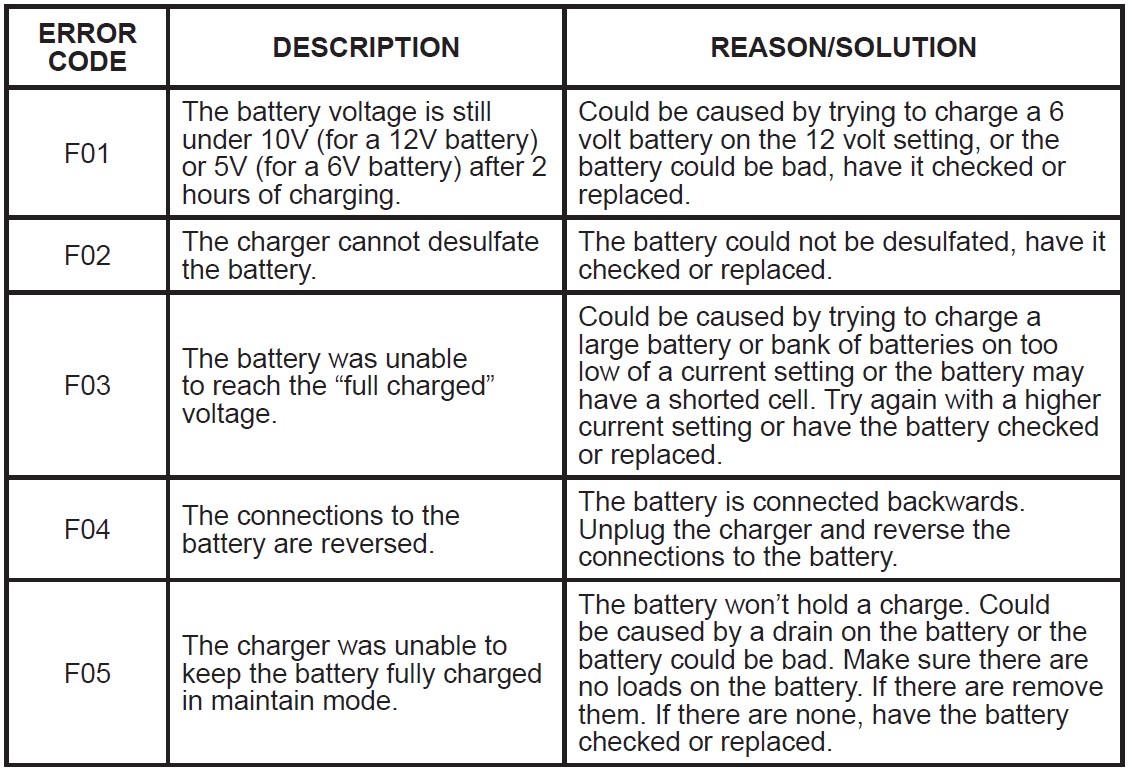 If you get a failure code, you have to check the connections and settings and/or replace the battery.
If you get a failure code, you have to check the connections and settings and/or replace the battery.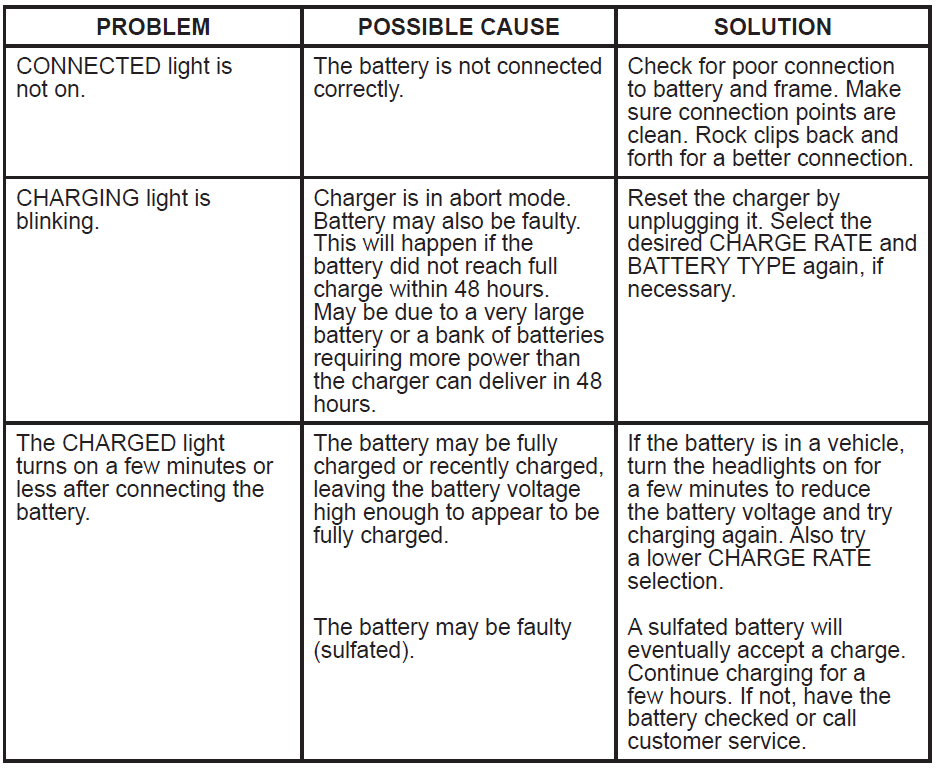
BEFORE RETURNING FOR REPAIRS
- When a charging problem arises, make certain that the battery is capable of accepting a normal charge. Use a good battery to double check all connections, AC outlet for a full 120-volts, charger clips for correct polarity and the quality of the connections from the cables to the clips and from the clips to the battery system. The clips must be clean.
- When a battery is very cold, partially charged or sulfated, it will not draw the full rated amperes from the charger. It is both dangerous and damaging to a battery to force higher amperage into it than it can effectively use in recharging.
- When an UNKNOWN OPERATING PROBLEM arises, please read the complete manual and call the customer service number for information that will usually eliminate the need for return.
Limited WARRANTY
Warranty not valid in Mexico.
SCHUMACHER ELECTRIC CORPORATION, 801 BUSINESS CENTER DRIVE, MOUNT PROSPECT, IL 60056-2179, MAKES THIS LIMITED WARRANTY TO THE ORIGINAL RETAIL PURCHASER OF THIS PRODUCT. THIS LIMITED WARRANTY IS NOT TRANSFERABLE OR ASSIGNABLE.
Schumacher Electric Corporation (the “Manufacturer”) warrants this battery charger for 5 years from the date of purchase at retail against defective material or workmanship that may occur under normal use and care. If your unit is not free from defective material or workmanship, the Manufacturer’s obligation under this warranty is solely to repair or replace your product with a new or reconditioned unit at the option of the Manufacturer. It is the obligation of the purchaser to forward the unit, along with mailing charges prepaid to the Manufacturer or its authorized representatives for repair or replacement to occur. The manufacturer does not provide any warranty for any accessories used with this product that are not manufactured by Schumacher Electric Corporation and approved for use with this product. This Limited Warranty is void if the product is misused, subjected to careless handling, repaired, or modified by anyone other than the Manufacturer, or if this unit is resold through an unauthorized retailer. The manufacturer makes no other warranties, including, but not limited to, express, implied or statutory warranties, including without limitation, any implied warranty of merchantability or implied warranty of fitness for a particular purpose. Further, Manufacturer shall not be liable for any incidental, special, or consequential damage claims incurred by purchasers, users or others associated with this product, including, but not limited to, lost profits, revenues, anticipated sales, business opportunities, goodwill, business interruption, and any other injury or damage. Any and all such warranties, other than the limited warranty included herein, are hereby expressly disclaimed and excluded. Some states do not allow the exclusion or limitation of incidental or consequential damages or the length of implied warranty, so the above limitations or exclusions may not apply to you. This warranty gives you specific legal rights, and it is possible you may have other rights that vary from this warranty.
THIS LIMITED WARRANTY IS THE ONLY EXPRESS LIMITED WARRANTY, AND THE MANUFACTURER NEITHER ASSUMES NOR AUTHORIZES ANYONE TO ASSUME OR MAKE ANY OTHER OBLIGATION TOWARDS THE PRODUCT OTHER THAN THIS WARRANTY.
For more manuals by Napa, visit ManualsLibraryy
Napa 85 435 Automatic Battery Charger-FAQs
Can I use the Rival Crock-Pot insert in the oven?
Yes, the removable stoneware insert (without the lid) can be used in a conventional oven up to 400°F. Do not place the lid in the oven.
Is the stoneware insert microwave safe?
Yes, the removable insert is safe for microwave use. Make sure to remove the lid before microwaving.
Can the crockery go in the dishwasher?
Yes, both the stoneware insert and lid are dishwasher safe for easy cleaning.
Can I use the Rival Crock-Pot on a stovetop?
No, the stoneware insert should not be used on a stovetop or under a broiler, as it may crack or break.
What temperature settings does it have?
Most Rival Crock-Pots offer Low, High, and Warm settings to suit different cooking needs.
How long can I leave food in the slow cooker?
You can safely cook food for 6–10 hours on Low or 4–6 hours on High, depending on the recipe.
Can I store leftovers in the stoneware insert?
Yes, the insert is refrigerator-safe. Let it cool to room temperature before refrigerating.
What should I avoid putting in the slow cooker?
Avoid adding frozen meat or liquids directly; always thaw items first to ensure even cooking.


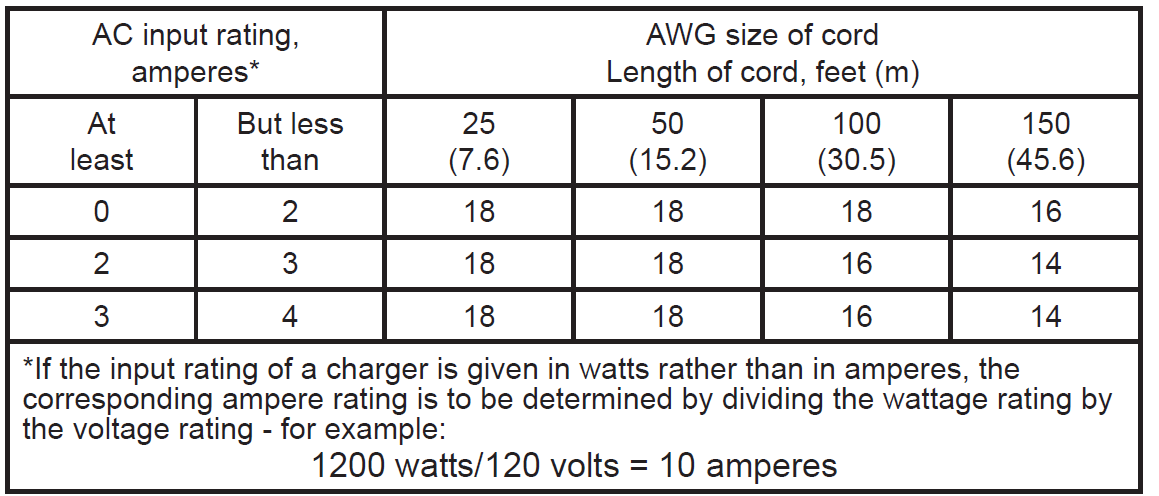

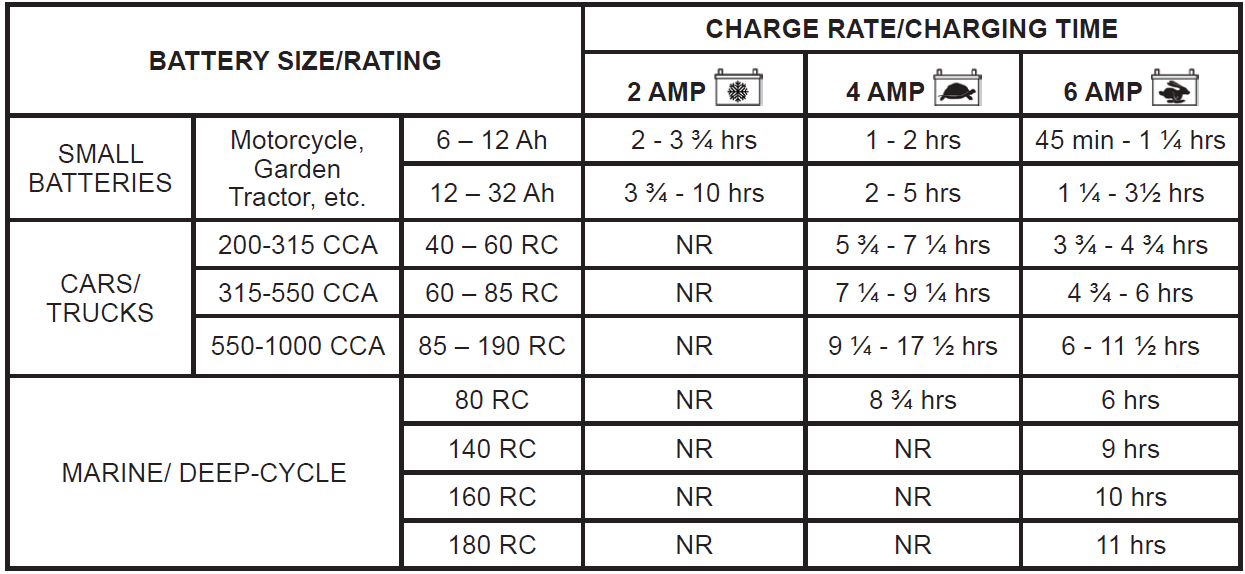 Model XC10
Model XC10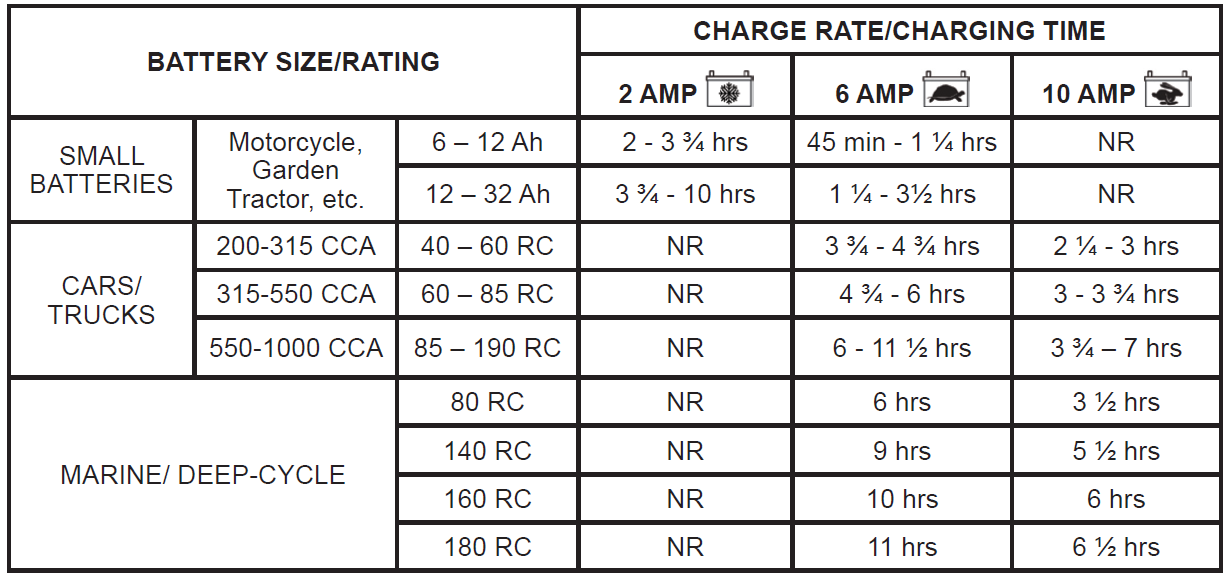 Model XC12
Model XC12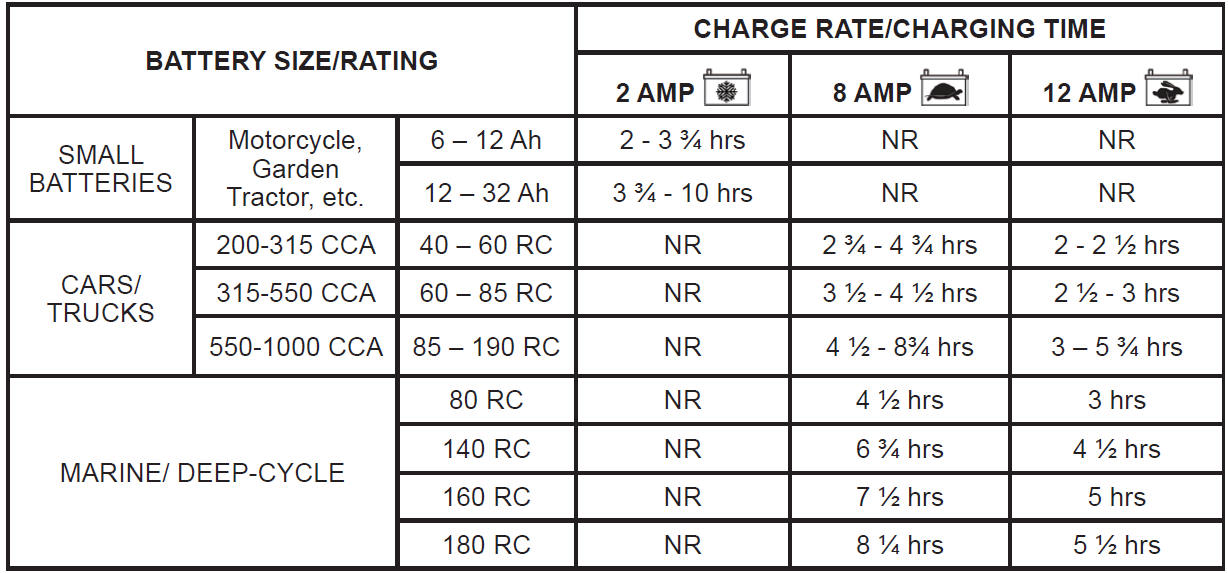 Model XCS15
Model XCS15